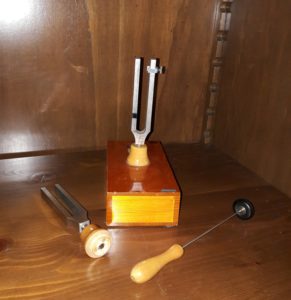
IT – L’invenzione del diapason, formato da una forcella di acciaio piegata a U e sostenuta nel mezzo, i cui rami si dicono rebbi, sembra risalire agli inizi del Settecento ad opera del musicista inglese John Shore, che suonava per il compositore tedesco naturalizzato inglese George Frideric Haendel. Montato su casse di risonanza, viene spesso utilizzato in coppia e può considerarsi una sorgente sonora che vibra di moto armonico semplice. Grazie all’uso di un martelletto ed un piccolo morsetto scorrevole in grado di cambiare la frequenza dell’onda emessa, è possibile studiare il fenomeno della risonanza o quello dei battimenti.
GB – Pair of tuning forks – The invention of the tuning fork, formed by a U-folded steel fork supported in the middle, whose branches are said to be prongs, seems to date back to the early eighteenth century by the English musician John Shore, who played for the German-born English composer George Frideric Haendel. Mounted on resonance boxes, it is often used in pairs and can be considered a sound source that vibrates with simple harmonic motion. Thanks to the use of a hammer and a small sliding clamp capable of changing the frequency of the emitted wave, it is possible to study the phenomenon of resonance or that of beats.